Centauri Dreams
Imagining and Planning Interstellar Exploration
Ravi Kopparapu: Looking at K2-72
Is the K2-72 system, discussed yesterday as part of a recent exoplanet announcement from Ian Crossfield and colleagues, as intriguing as it looks? Ravi Kopparapu has some thoughts on the matter. Dr. Kopparapu’s work on exoplanet habitability is well known to Centauri Dreams readers — he offered an overview in these pages called How Common Are Potential Habitable Worlds in Our Galaxy?, which ran in 2014. An assistant research scientist at NASA GSFC and the University of Maryland, Dr. Kopparapu began his exoplanet career with James Kasting at Penn State following work on the LIGO collaboration enroute to his PhD from Louisiana State. Analyzing habitable zone possibilities around different kind of stars, as well as modeling and characterizing exoplanet atmospheres, plays a major role in his research interests. I was pleased to receive the following note on the recently announced K2-72 system and want to run his thoughts today given the interest this unusual system has already begun to generate.
By Ravi Kumar Kopparapu

Having read your article on new K2 planet discoveries on Centauri Dreams (see Intriguing System in New Exoplanet Haul), I was interested to go back to Crossfield’s paper to look more carefully at the data tables given at the end of their paper. I found couple of interesting things, which I am sure the team must have noticed too.
1. The paper, and your article, mentions a system with four potentially rocky worlds (I am using ‘potentially’ here because I am hoping there may be more refined measurements of the stellar radius eventually), and “The irradiation levels for several planets are also quite consistent with Earth’s insolation.” This system is listed as K2-72 in Ian’s data tables.
I looked at this table, and found that out of the four, two of them (K2-72c and K2-72e) can be considered to be in the Habitable Zone (HZ) of the host star. The habitable zone limits are from my climate model calculations. [See citations at the end of this post].
Particularly, these two planets are very close in size with each other….just like Earth and Venus. I think K2-72e is most definitely in the HZ (incident flux = 0.76 Earth flux), while K2-72c is receiving about twice (~1.41 Earth flux) the stellar flux as K2-72e. So, I think the ‘e’ and ‘c’ planets are like Earth and Venus, respectively, in our Solar system. (Venus receives about twice the Earth flux).
Now, there are some 3-D climate model results, including some from our group, that keep the planet ‘c’ comfortably within the HZ, if that planet is covered with oceans. In that case, the K2-72 system would have two potential habitable planets (please note my stress on ‘potential’). We do not know the water content of planet ‘c’, so we can not make any definitive statements. So, to be on the safe side, let’s assume there is an Earth-Venus twin in the K2-72 system.
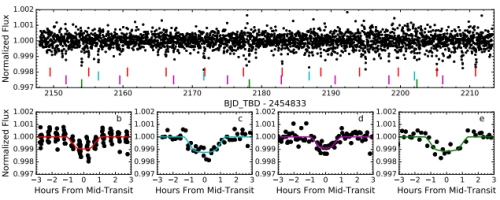
Image: Photometry of K2-72 (EPIC 206209135), which hosts four transiting planets. Top: Full time series with colored tick marks indicating each individual transit time. Bottom: Phase-folded photometry with the color-coded, best-fit transit model overplotted for each planet. Credit: Crossfield et al.
2. There is another interesting system that also got my attention: K2-3d and K2-3c. These planets are nearly Earth-size, and as with the K2-72 system, they are also very similar in size with each other….as are Earth & Venus in our Solar system. What’s more, the stellar flux incident on these planets also varies by a factor of two between each other (0.8 Earth flux for K2-3d, and 1.77 Earth flux for K2-3c)…just as Earth & Venus!
The similarities of these systems with Earth and Venus based only on size and incident flux (which is the only thing we can measure now with transit photometry) are astonishing. These two systems would be excellent candidates for follow-up characterization campaigns depending upon how bright are the host stars. It is amazing that within the bounty of planets from this data, there are already two systems VERY close to Earth-Venus similarities.
For more on Dr. Kopparapu’s habitable zone calculations, see Kopparapu et al., “Habitable Zones Around Main-Sequence Stars: New Estimates,” Astrophysical Journal, 765 (2013), 131 (abstract). See also Kopparapu et al, “Habitable Zones Around Main-Sequence Stars: Dependence on Planetary Mass” Astrophysical Journal Letters, 787 (2014), L29 (abstract).

Intriguing System in New Exoplanet Haul
Today’s announcement of the confirmation of over 100 planets using K2 data reminds me of how much has gone into making K2 a success. You’ll recall that K2 emerged when the Kepler spacecraft lost function in two of its four reaction wheels. Three of these were needed for pointing accuracy, but ingenious pointing techniques and software updates have made K2 into a potent project of its own. The latest announcements demonstrate that certain benefits emerged from the changed mission parameters, especially in the ability of K2 to move away from the original field of view (toward Cygnus and Lyra) and focus on targets in the ecliptic plane.
What we gain from that change is that working in the ecliptic allows more chances for observation from ground-based observatories in both northern and southern hemispheres as they perform the needed exoplanet follow-up. But there are other factors that make K2 potent. With all targets being chosen by the entire scientific community (not limited to the original science team members), we’re drilling down into smaller red dwarf stars. Thus Ian Crossfield (University of Arizona), who is behind the latest tranche of exoplanet discoveries:
“Kepler’s original mission observed a small patch of sky as it was designed to conduct a demographic survey of the different types of planets. This approach effectively meant that relatively few of the brightest, closest red dwarfs were included in Kepler’s survey. The K2 mission allows us to increase the number of small, red stars by a factor of 20 for further study.”
The paper on the new announcement elaborates on the Kepler/K2 distinction:
K2 observes a qualitatively different stellar population than Kepler, namely a much larger fraction of late-type stars [i.e., K and M-class]… Stellar parameters for these late-type systems derived from photometry alone are relatively uncertain, and follow-up spectroscopy is underway to characterize these stars… In addition to the difference in median spectral type, K2 also surveys a much broader range of Galactic environments than was observed in the main Kepler mission. These two factors suggest that, once K2 ’s detection efficiency is improved and quantified, the mission’s data could address new questions about the intrinsic frequency of planets around these different stellar populations.
That factor of 20 increase in small red stars is paying off handsomely. We now have 104 newly confirmed planets, among them a planetary system containing four interesting potentially rocky worlds. Although all four of these planets orbit within the distance of Mercury’s orbit around the Sun, the star itself is an M-dwarf less than half the Sun’s size. The planetary orbital periods go from 5.58 days to 24 days, and according to the paper on this work, “The irradiation levels for several planets are also quite consistent with Earth’s insolation.”
The host of the four planets is the M-dwarf K2-72, all four of whose planets have been validated. The orbital periods here are 5.58, 7.76, 15.19, and 24.16 days, with the authors noting that planets c and d orbit near a first-order 2:1 mean motion resonance, or MMR (in a first-order resonance, the integers in the ratio differ by one), while b and c orbit near a second-order 7:5 MMR. Planetary radii are in the range of 1.2–1.5 R? for all planets.
All of this is exciting news, though we still have challenges in future observation. The star is faint enough to make Doppler or transit spectroscopy observations, needed to measure planetary mass or perform atmospheric analysis, difficult. It may be that transit timing variations will be helpful in analyzing the masses and bulk densities of these worlds.

Image: A montage showing the Mauna Kea Observatories, Kepler Space Telescope, and night sky with K2 Fields and discovered planetary systems (dots) overlaid. An international team of scientists discovered more than 100 planets based on images from Kepler operating in the K2 Mission. The team confirmed and characterized the planets using a suite of telescopes worldwide, including four on Mauna Kea (the twin telescopes of Keck Observatory, the Gemini-North Telescope, and the Infrared Telescope Facility). The planet image on the right is an artist’s impression of a representative planet. Credit: Karen Teramura/IFA; Miloslav Druckmüller/NASA.
Of the 104 planets, 64 are validated in this paper for the first time, and we still have another 63 remaining planet candidates. The paper tells us that the new discoveries include 37 planets smaller than two Earth radii (2R?), and several multi-planet systems. The complete list of these worlds is found in the research paper cited below, which points out that K2 may be able to double or triple the number of small planets detected around nearby stars. 500 ? 1000 planets are likely to be discovered in K2’s planned four-year mission.
That’s good news, of course, for future attempts to measure the composition of planetary atmospheres with the James Webb Space Telescope, to be launched in 2018, and it feeds excitement for the upcoming Transiting Exoplanet Survey Satellite (TESS) mission, due for launch next year.. We’re just getting a taste here of what TESS is likely to give us. From the paper:
The size of our validated-planet sample demonstrates yet again the power of high-precision time-series photometry to discover large numbers of new planets, even when obtained from the wobbly platform of K2. Since K2 represents a natural transition from the narrow-field, long-baseline Kepler mission to the nearly all-sky, mostly short-baseline TESS survey, the results of our K2 efforts bode well for the productivity of the upcoming TESS mission. The substantial numbers of intermediate-sized planets orbiting moderately bright stars discovered by our (and other) K2 surveys… will be of considerable interest for future follow-up characterization via radial velocity spectroscopy and JWST transit observations…
The paper is Crossfield et al., “197 Candidates and 104 Validated Planets in K2’s First Five Fields,” to be published in Astrophysical Journal Supplement Series (preprint). A Keck University news release is also available.

A New Dwarf Planet (and its Implications)
A dwarf planet designated 2015 RR245 (and now in search of a name) has been found in an orbit that takes it out to at least 120 AU. It’s a discovery made by the Outer Solar System Origins Survey (OSSOS), an international collaboration focused on the Solar System beyond Neptune. The goal is to test models of how the Solar System developed by studying the movements of icy objects, many of which may have been destroyed or ejected from the Solar System altogether through movements of the giant planets early in the formation process.
Image: Rendering of the orbit of RR245 (orange line). Objects as bright or brighter than RR245 are labeled. The blue circles show the projected orbits of the major planets. The Minor Planet Center describes the object as the 18th largest in the Kuiper Belt. Credit: Alex Parker/OSSOS team.
We’ve had a close look at one dwarf planet at the edge of the system when New Horizons flew past Pluto a year ago, and with a diameter of roughly 700 kilometers, 2015 RR245 will itself be worthy of future investigation. We now know from the New Horizons example that distant icy worlds like these produce exotic landscapes and unexpected geological processes. But their orbits may tell us just as much as their surface features. Consider:
Perihelion for 2015 RR245 will take place toward the end of this century, though refining its orbit will take time. According to the project’s website, OSSOS can work out TNO orbits in about 16 months on average, which is actually less than 1% of the time it takes them to orbit the Sun. While thinking about these orbits, bear in mind that although the number of TNOs so far discovered is growing, we’re surely seeing a small subset of what must be a vast population.
We’re tracking, in other words, only those objects that are relatively close to the Sun and thus are the easiest to spot. Michele Bannister (University of Victoria BC) touches on the matter in this news release:
“The icy worlds beyond Neptune trace how the giant planets formed and then moved out from the Sun. They let us piece together the history of our Solar System. But almost all of these icy worlds are painfully small and faint: it’s really exciting to find one that’s large and bright enough that we can study it in detail.”
But the fact that we find so few TNOs that are large and bright enough for such study is itself an issue. The second Kuiper Belt Object found (1992 QB1) was discovered over sixty years after the first (Pluto), an indication of how small and faint these objects are. Ethan Siegel speaks to this in an essay for Forbes, noting that objects like 2015 RR245 have extremely eccentric orbits, in this case one with perihelion at roughly 34 AU and aphelion at 120 AU.
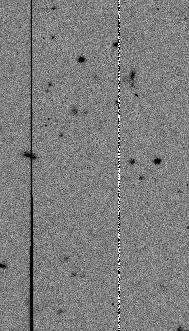
We’re reminded that we have not just Kuiper Belt Objects to contend with but scattered disk objects as well (scattered disk objects are considered to be KBOs with large orbital eccentricities), and beyond them the so-called Sednoids. This has implications for the conjectured Planet Nine, whose existence has been inferred through the clustering of a small number of Sednoid objects. Siegel has his doubts, and they’re reinforced by 2015 RR245:
But it’s also possible, as scattered disk objects and elliptical KBOs show, that there are a huge variety of objects with tremendously varied orbits out there, and we’re only seeing a tiny fraction of them. If the objects we’re seeing have even a slight bias to them, it could lead us to jump to all sorts of incorrect conclusions, just as we did decades ago claiming periodic mass extinctions due to asteroid impacts and the Nemesis theory of a second Sun. Incomplete data is what we’ve got, and the first results of OSSOS and the discovery of 2015 RR245 should remind us all of how much more there is — not just in the Universe but even in our Solar System — still left to discover.
Image: Discovery images of RR245. The images show RR245’s slow motion across the sky over three hours. Credit OSSOS team.
Meanwhile, OSSOS plugs away, having already discovered more than five hundred new trans-Neptunian objects. 2015 RR245 is its largest discovery and the only dwarf planet found by the team, which uses the MegaPrime camera, an imager on the 3.6m Canada-France-Hawaii Telescope (CFHT). As larger telescopes like the Large Synoptic Survey Telescope (LSST) come online capable of mapping the entire visible sky in just a few nights, we will doubtless gain a better idea of the actual distribution of these varied objects. That may put to bed once and for all the question of whether a large undiscovered planet is out there at system’s edge.

Updates from Jupiter and Ceres
We don’t have high-resolution pictures of Jupiter from the Juno mission yet, but we do have JunoCam in operation. It’s a color camera working in visible light that has returned data following the spacecraft’s arrival at Jupiter on July 4. This JPL news release tells us that JunoCam was folded into the mission as part of NASA’s public outreach. It is not, in other words, considered a science instrument, and we’ll need to wait until late August for the first high-resolution images. Still, it’s satisfying to see that all is apparently well in Jupiter space.
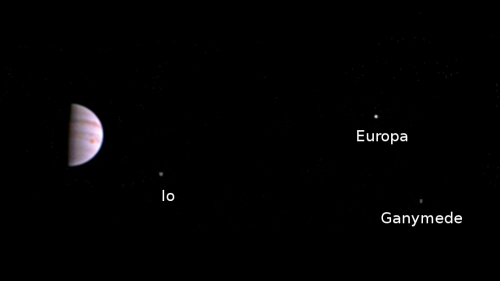
Image: This color view from NASA’s Juno spacecraft is made from some of the first images taken by JunoCam after the spacecraft entered orbit around Jupiter on July 5th (UTC). The view shows that JunoCam survived its first pass through Jupiter’s extreme radiation environment, and is ready to collect images of the giant planet as Juno begins its mission. Credit: NASA/JPL-Caltech/SwRI/MSSS.
Here we’re about 4.3 million kilometers from Jupiter on the outbound leg of the initial 53.5-day capture orbit, a view that yields atmospheric features including the Great Red Spot, along with three of the Galilean moons. Io, Europa and Ganymede appear from left to right in the image. Bear in mind that as the mission progresses, Juno will at times close to within 4100 kilometers of the cloud tops. Spectacular high-resolution views are ahead.
The View from Ceres
We might well find ice deposits on the surface of Ceres. That’s the word from researchers with the Dawn mission, who have been looking at permanently shadowed areas on the dwarf planet. Areas like these are generally on a crater floor or along a part of the crater wall facing the pole. With temperatures below -151 degrees Celsius (122 K) these areas become cold traps, where water ice can accumulate and remain stable for a billion years.
“The conditions on Ceres are right for accumulating deposits of water ice,” said Norbert Schorghofer, a Dawn guest investigator at the University of Hawaii at Manoa. “Ceres has just enough mass to hold on to water molecules, and the permanently shadowed regions we identified are extremely cold — colder than most that exist on the moon or Mercury.”
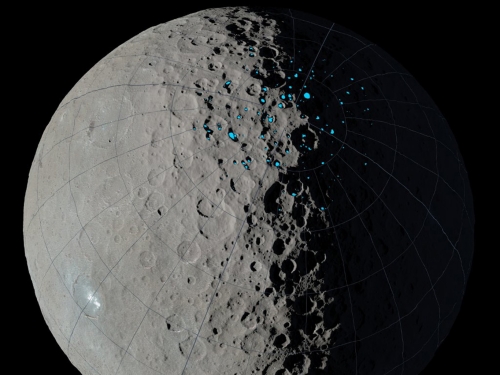
Image: At the poles of Ceres, scientists have found craters that are permanently in shadow (indicated by blue markings). Such craters are called “cold traps” if they remain below about minus 151 degrees Celsius. These shadowed craters may have been collecting ice for billions of years because they are so cold. Credit: NASA/JPL-Caltech/UCLA/MPS/DLR/IDA.
Using computer modeling in conjunction with Dawn’s camera imagery, Schorghofer and colleagues could analyze surface features in great detail, learning which areas receive direct sunlight and how changes during the course of a year on Ceres (1680 days) affect the solar radiation reaching the surface. Dozens of permanently shaded regions turned up in the northern hemisphere, the largest (inside a 16-kilometer crater) less than 65 kilometers from the north pole. Altogether, these regions make up about 1800 square kilometers.
As opposed to the Moon and Mercury (which, like Ceres, have a very small spin axis tilt, or obliquity), the cold trap regions on Ceres extend much further toward the equator. The permanently shadowed regions have to be close to the poles on the Moon and Mercury to get cold enough for ice to remain stable. But like Mercury, these areas account for about the same fraction — less than one percent — of the surface area of the northern hemisphere, and most of these areas on Ceres are cold enough to serve as efficient cold traps for water ice.
All of this has useful implications if we’re thinking ahead to one day exploiting Ceres’ resources:
“While cold traps may provide surface deposits of water ice as have been seen at the moon and Mercury, Ceres may have been formed with a relatively greater reservoir of water,” said Chris Russell (UCLA), principal investigator of the Dawn mission. “Some observations indicate Ceres may be a volatile-rich world that is not dependent on current-day external sources.”
It’s also interesting to note that we don’t know the origin of the ice in the cold traps of either Mercury or the Moon. A possible source is incoming comets, meteorites or interplanetary dust particles, but as the paper on this work notes, we might also find ice generated from solar wind interactions (a mechanism not fully understood) or even outgassing. We would expect, however, that solar wind-generated water resources would be less common with greater distance from the Sun, while infalling H2O would be higher on Ceres than on Mercury because of Ceres’ location in the asteroid belt. Which leads us, the paper notes, to a way to investigate further:
…the trapping efficiency on Mercury and Ceres are similar; that is, for the same number of generated water molecules per surface area, the thickness of the ice accumulating in the cold traps should be almost as high on Ceres than on Mercury. Hence, significant differences in the thickness of young ice deposits may reveal the main source of water. A lack of ice deposits in Cerean cold traps would suggest that infall is not a major source of this ice, consistent with a solar wind generation mechanism on Mercury.
We can, the paper argues, expect fresh and perhaps optically bright ice deposits in the cold traps of Ceres, even without any further water delivery. The authors calculate that about 1 out of every 1000 water molecules generated on the surface of Ceres will wind up in a cold trap during a Cerean year. The upshot: Thin but detectable ice deposits over a 100,000 year period.
The paper is Schorghofer et al., “The permanently shadowed regions of dwarf planet Ceres,” Geophysical Research Letters 6 July 2016 (full text). A JPL news release is also available.

Viewing a Protoplanetary Snowline
A team led by Lucas Cieza (Universidad Diego Portales, Santiago, Chile) has produced the first image directly showing the water snowline in a protoplanetary disk, using the Atacama Large Millimeter/submillimeter Array (ALMA). It’s fascinating to actually see a mechanism we’ve long discussed in these pages when analyzing exoplanetary systems (or for that matter, our own). We have a young star called V883 Orionis to thank for the possibility. It’s an FU Orionis star of the kind we recently looked at in FU Orionis: Implications of Sudden Brightening for Planet Formation. And here, too, the implications are rich.
FU Orionis stars are young, pre-main sequence objects that can produce extreme changes in magnitude and spectral type. The eponymous FU Orionis itself, 1500 light years away in the constellation Orion, underwent an event in 1936 that took it from a visual magnitude of 16.5 to 9.6. In the case of V883 Orionis, a similar outburst in temperature and luminosity has heated the protoplanetary disk while making the star 400 times more luminous than the Sun, although it is only 30% more massive. The snowline has been pushed out to a distance great enough for us to observe.
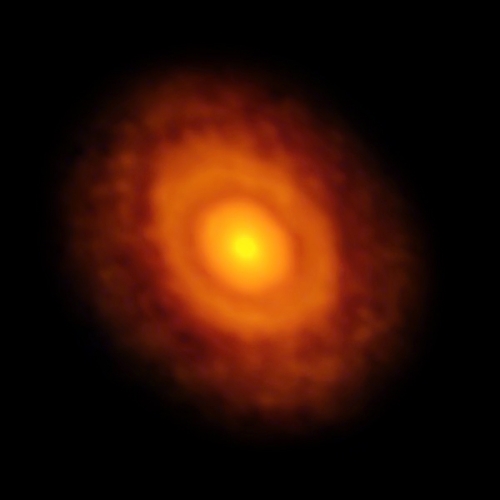
Image: This image of the planet-forming disc around the young star V883 Orionis was obtained by ALMA in long-baseline mode. This star is currently in outburst, which has pushed the water snowline further from the star and allowed it to be detected for the first time. The dark ring midway through the disc is the water snowline, the point from the star where the temperature and pressure dip low enough for water ice to form. Credit: ALMA (ESO/NAOJ/NRAO)/L. Cieza.
The protoplanetary disk surrounding a young star is usually gaseous within several AU of the star, but beyond this distance, lowering temperatures and pressure allow water to sublimate; i.e., water molecules can go directly from the gaseous state to form ice on dust grains and other particles, with no intervening liquid state. Sublimation contributes to the ability of dust grains to clump together, a key process in the beginning of planet formation.
Because water freezes at a relatively high temperature, the water snowline is usually too close to a young star to allow observatories to distinguish it. But because of the star’s recent outburst, V883 Orionis’ snowline has been pushed out ten times as far as usual, to a distance of about 40 AU, roughly the size of Pluto’s orbit. This allows ALMA, which has a resolution at this distance of about 12 AU, to produce the above image.
This kind of outburst is likely a stage that most planetary systems go through. In other words, what we are seeing here may well be common in infant systems, giving us a look at how planet formation occurs throughout the galaxy. Bear in mind that the snowlines for other molecules have already been observed. As distance from a star increases and temperatures drop, molecules like carbon dioxide (CO2), carbon monoxide (CO) and methane (CH4) exhibit snowlines of their own, likewise aiding the planet formation process. The snowline of carbon monoxide around TW Hydrae was imaged by ALMA in 2013.
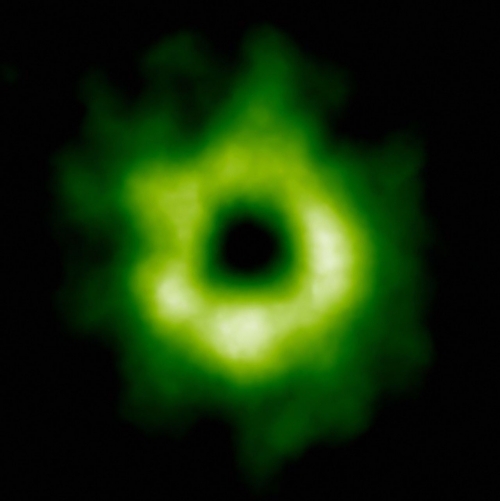
Image: This ALMA image shows the region where carbon monoxide snow has formed around TW Hydrae. The carbon monoxide is shown here in green, and begins at a distance of more than 30 astronomical units from TW Hydrae. Aside from being necessary for planetary and comet formation, carbon monoxide is needed for the creation of methanol, which is a fundamental building block required for life. Credit: ALMA (ESO/NAOJ/NRAO).
We still have much to learn about V883 Orionis-style stellar outbursts, but the assumption is that large amounts of disk material are being consumed by the star, flash-heating the disk. These sudden accretion events add mass to the star while temporarily adjusting the snowlines for various molecules. The presence of the water snowline between Mars and Jupiter during the formation of the Solar System helps us understand how rocky planets form, in a region where water is vaporized well inside the snowline, with gaseous planets forming beyond this limit.
The paper is Cieza et al., “Imaging the water snow-line during a protostellar outburst,” Nature 14 July 2016.

Into the Nebula: Low-Mass Objects in Orion
Because we want to learn more about how stars form, we study the so-called Initial Mass Function, which tells us, for a given population of stars, the distribution of their initial masses. As one recent reference (the Encyclopedia of Astrobiology, Springer, 2011) puts it: “The initial mass function is the relative number of stars, as a function of their individual initial mass, that forms during a single star forming episode.” Figuring out the IMF for places like the Orion Nebula, visible from Earth with the naked eye as a patch in Orion’s sword, is a start in learning how this grouping of stars formed.
About 1350 light years from Earth, the Orion Nebula is known as an H II region, a reference to the fact that it contains ionized hydrogen in its star-forming, gaseous depths. A surprise emerged when the European Southern Observatory put its HAWK-I infrared instrument on the Very Large Telescope to work on the nebula. What turned up were faint brown dwarfs and isolated objects of planetary mass in much larger numbers than expected. Says Amelia Bayo (Universidad de Valparaíso, Chile), a co-author of the paper describing the results:
“Understanding how many low-mass objects are found in the Orion Nebula is very important to constrain current theories of star formation. We now realise that the way these very low-mass objects form depends on their environment.”
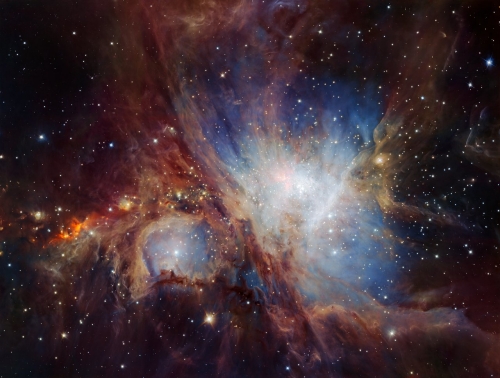
Image: A deep infrared view of the Orion Nebula from HAWK-I. Credit: ESO.
Indeed. The sheer numbers involved here show us that the Orion Nebula may be forming far more low-mass objects than less active star formation areas. The study finds that apart from 929 low-mass stars (less than 1.4 times the mass of the Sun), the Orion Nebula’s Initial Mass Function contains some 757 brown dwarf candidates and 158 ‘isolated planetary mass objects’ (IPMO). The latter have masses greater than 0.005 Solar masses. Overall, the study finds a high fraction of substellar objects (about 50%), ten times more than previously estimated.
Before HAWK-I went to work, the largest grouping of objects known in the Orion Nebula were about one quarter as massive as the Sun. We now have a second maximum to work with at a much lower level of mass. How to explain this ‘bimodal Initial Mass Function’? The authors argue that the excess of brown dwarfs and planetary mass objects is probably produced by ejected material from circumstellar disks, citing recent simulations on pre-stellar disk fragmentation. “We suggest that the final explanation for Orion’s bimodal IMF has to be searched for along that direction.”
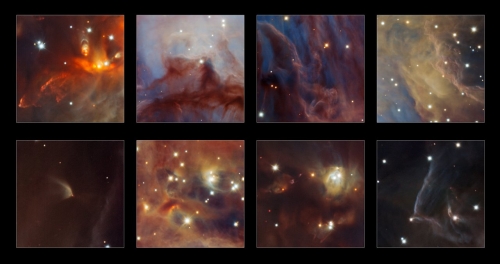
Image: Highlights from a new infrared image of the Orion Nebula. Credit: ESO.
Exactly how we define a brown dwarf is not yet a settled matter, as we saw in the discussion of WISE 0855 in yesterday’s post. One common definition places brown dwarfs between roughly 13 and 75 Jupiter masses, with smaller objects sometimes referred to as rogue planets or sub-brown dwarfs. The paper we looked at yesterday by Andrew Skemer et al. calls WISE 0855 a brown dwarf although it is about five Jupiter masses, evidently because it is thought to have evolved from a collapsing protostellar cloud rather than within a protoplanetary disk.
As we work out such definitions, we have a great deal to learn about objects throughout this mass range. The Orion Nebula is considered a benchmark for studying the Initial Mass Function of young star-forming regions and the substellar mass objects that also populate them. The HAWK-I instrument (High Acuity Wide-field K-band Imager) observes in the 0.9-2.5 μm near-infrared spectral range to see through dust to detect cooler stars and planets. The fact that we have numerous planet-sized objects showing up at the current observational limit raises hopes that the European Extremely Large Telescope and other ELTs slated for the 2020s will be able to mount an observing campaign targeting these and perhaps much smaller worlds.
The paper is Drass et al., “The bimodal initial mass function in the Orion Nebula Cloud,” accepted at Monthly Notices of the Royal Astronomical Society (abstract / preprint).



